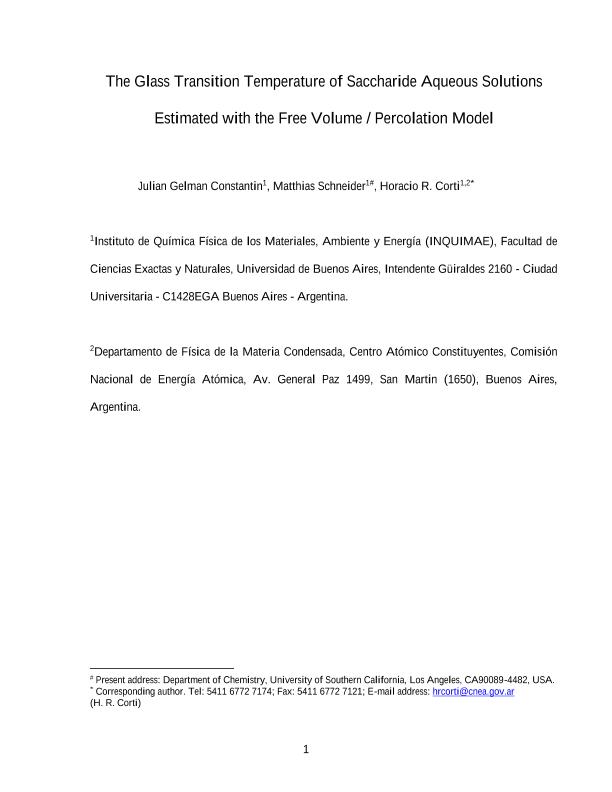Mostrar el registro sencillo del ítem
dc.contributor.author
Gelman Constantin, Julián

dc.contributor.author
Schneider, Matthias
dc.contributor.author
Corti, Horacio Roberto

dc.date.available
2018-05-14T18:59:10Z
dc.date.issued
2016-05
dc.identifier.citation
Gelman Constantin, Julián; Schneider, Matthias; Corti, Horacio Roberto; Glass Transition Temperature of Saccharide Aqueous Solutions Estimated with the Free Volume/Percolation Model; American Chemical Society; Journal of Physical Chemistry B; 120; 22; 5-2016; 5047-5055
dc.identifier.issn
1520-6106
dc.identifier.uri
http://hdl.handle.net/11336/45124
dc.description.abstract
The glass transition temperature of trehalose, sucrose, glucose, and fructose aqueous solutions has been predicted as a function of the water content by using the free volume/percolation model (FVPM). This model only requires the molar volume of water in the liquid and supercooled regimes, the molar volumes of the hypothetical pure liquid sugars at temperatures below their pure glass transition temperatures, and the molar volumes of the mixtures at the glass transition temperature. The model is simplified by assuming that the excess thermal expansion coefficient is negligible for saccharide–water mixtures, and this ideal FVPM becomes identical to the Gordon–Taylor model. It was found that the behavior of the water molar volume in trehalose–water mixtures at low temperatures can be obtained by assuming that the FVPM holds for this mixture. The temperature dependence of the water molar volume in the supercooled region of interest seems to be compatible with the recent hypothesis on the existence of two structure of liquid water, being the high density liquid water the state of water in the sugar solutions. The idealized FVPM describes the measured glass transition temperature of sucrose, glucose, and fructose aqueous solutions, with much better accuracy than both the Gordon–Taylor model based on an empirical kGT constant dependent on the saccharide glass transition temperature and the Couchman–Karasz model using experimental heat capacity changes of the components at the glass transition temperature. Thus, FVPM seems to be an excellent tool to predict the glass transition temperature of other aqueous saccharides and polyols solutions by resorting to volumetric information easily available.
dc.format
application/pdf
dc.language.iso
eng
dc.publisher
American Chemical Society

dc.rights
info:eu-repo/semantics/openAccess
dc.rights.uri
https://creativecommons.org/licenses/by-nc-sa/2.5/ar/
dc.subject
Glass Transition
dc.subject
Saccharide
dc.subject
Water
dc.subject
Free Volume
dc.subject.classification
Otras Ciencias Químicas

dc.subject.classification
Ciencias Químicas

dc.subject.classification
CIENCIAS NATURALES Y EXACTAS

dc.subject.classification
Alimentos y Bebidas

dc.subject.classification
Otras Ingenierías y Tecnologías

dc.subject.classification
INGENIERÍAS Y TECNOLOGÍAS

dc.title
Glass Transition Temperature of Saccharide Aqueous Solutions Estimated with the Free Volume/Percolation Model
dc.type
info:eu-repo/semantics/article
dc.type
info:ar-repo/semantics/artículo
dc.type
info:eu-repo/semantics/publishedVersion
dc.date.updated
2018-05-11T20:39:10Z
dc.journal.volume
120
dc.journal.number
22
dc.journal.pagination
5047-5055
dc.journal.pais
Estados Unidos

dc.journal.ciudad
Washington
dc.description.fil
Fil: Gelman Constantin, Julián. Consejo Nacional de Investigaciones Científicas y Técnicas. Oficina de Coordinación Administrativa Ciudad Universitaria. Instituto de Química, Física de los Materiales, Medioambiente y Energía. Universidad de Buenos Aires. Facultad de Ciencias Exactas y Naturales. Instituto de Química, Física de los Materiales, Medioambiente y Energía; Argentina
dc.description.fil
Fil: Schneider, Matthias. Consejo Nacional de Investigaciones Científicas y Técnicas. Oficina de Coordinación Administrativa Ciudad Universitaria. Instituto de Química, Física de los Materiales, Medioambiente y Energía. Universidad de Buenos Aires. Facultad de Ciencias Exactas y Naturales. Instituto de Química, Física de los Materiales, Medioambiente y Energía; Argentina
dc.description.fil
Fil: Corti, Horacio Roberto. Consejo Nacional de Investigaciones Científicas y Técnicas. Oficina de Coordinación Administrativa Ciudad Universitaria. Instituto de Química, Física de los Materiales, Medioambiente y Energía. Universidad de Buenos Aires. Facultad de Ciencias Exactas y Naturales. Instituto de Química, Física de los Materiales, Medioambiente y Energía; Argentina
dc.journal.title
Journal of Physical Chemistry B

dc.relation.alternativeid
info:eu-repo/semantics/altIdentifier/url/http://pubs.acs.org/doi/abs/10.1021/acs.jpcb.6b01841
dc.relation.alternativeid
info:eu-repo/semantics/altIdentifier/doi/https://dx.doi.org/10.1021/acs.jpcb.6b01841
Archivos asociados
